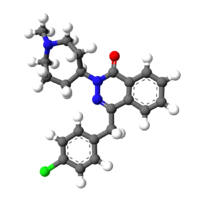User:Mr. Ibrahem/Azelastine
 | |
 | |
| Clinical data | |
|---|---|
| Trade names | Astelin, Optivar, Allergodil, others.[1] |
| AHFS/Drugs.com | Monograph |
| MedlinePlus | a603009 |
| License data |
|
| Routes of administration | Eye drops, nasal spray, by mouth |
| Drug class | 2nd-generation antihistamine[2][3] |
| Legal status | |
| Legal status | |
| Pharmacokinetic data | |
| Bioavailability | 40% (intranasal) |
| Elimination half-life | 22 hours |
| Identifiers | |
| |
| Chemical and physical data | |
| Formula | C22H24ClN3O |
| Molar mass | 381.90 g·mol−1 |
| 3D model (JSmol) | |
| |
| |
| (verify) | |
Azelastine, sold under the brand name Optivar among others, is a medication primarily used as a nasal spray to treat allergic rhinitis (hay fever) and as eye drops for allergic conjunctivitis.[4][3] Other uses may include asthma and skin rashes for which it is taken by mouth.[2] Onset of effects is within minutes when used in the eyes and within an hour when used in the nose.[3] Effects last for up to 12 hours.[3]
Common side effects include headache, sleepiness, change in taste, and sore throat.[3] It is unclear if use is safe during pregnancy or breastfeeding.[7] It is a second-generation antihistamine and works by blocking the release of a number of inflammatory mediators including histamine.[2][3]
Azelastine was patented in 1971 and came into medical use in 1986.[8] It is available as a generic medication. A 22 millilitre bottle in the United Kingdom costs the NHS about £10.50 as of 2019.[4] In the United States the wholesale cost of this amount is about US$8.40.[9] In 2017, it was the 297th most commonly prescribed medication in the United States, with more than one million prescriptions.[10][11]
References[edit]
- ^ Drugs.com Drugs.com international listings for azelastine Archived 2016-06-05 at the Wayback Machine Page accessed June 28, 2015
- ^ a b c Aronson, Jeffrey K. (2015). Meyler's Side Effects of Drugs: The International Encyclopedia of Adverse Drug Reactions and Interactions. Elsevier. p. 782. ISBN 9780444537164. Archived from the original on 2019-03-27. Retrieved 2019-03-26.
- ^ a b c d e f g h "Azelastine Hydrochloride Monograph for Professionals". Drugs.com. American Society of Health-System Pharmacists. Archived from the original on 2019-03-26. Retrieved 2019-03-26.
- ^ a b c British national formulary : BNF 76 (76 ed.). Pharmaceutical Press. 2018. p. 1169. ISBN 9780857113382.
- ^ "WHOCC - ATC/DDD Index". www.whocc.no. Archived from the original on 30 January 2021. Retrieved 9 September 2020.
- ^ "WHOCC - ATC/DDD Index". www.whocc.no. Archived from the original on 20 September 2020. Retrieved 9 September 2020.
- ^ "Azelastine ophthalmic (Optivar) Use During Pregnancy". Drugs.com. Archived from the original on 26 March 2019. Retrieved 26 March 2019.
- ^ Fischer, Jnos; Ganellin, C. Robin (2006). Analogue-based Drug Discovery. John Wiley & Sons. p. 548. ISBN 9783527607495. Archived from the original on 2020-03-06. Retrieved 2019-03-03.
- ^ "NADAC as of 2019-02-27". Centers for Medicare and Medicaid Services. Archived from the original on 2019-03-06. Retrieved 3 March 2019.
- ^ "The Top 300 of 2020". ClinCalc. Archived from the original on 12 February 2021. Retrieved 11 April 2020.
- ^ "Azelastine Hydrochloride - Drug Usage Statistics". ClinCalc. Archived from the original on 13 April 2020. Retrieved 11 April 2020.
